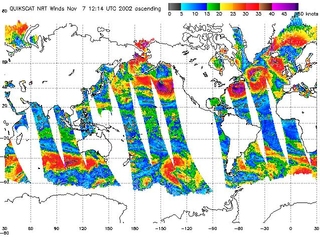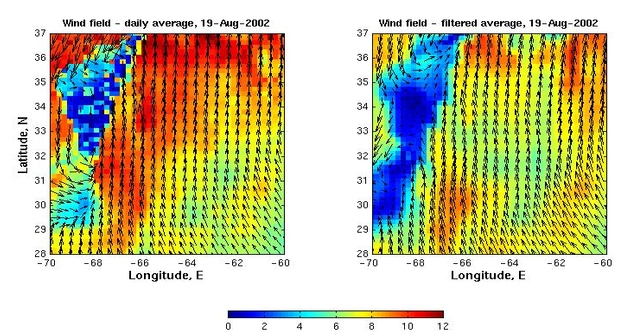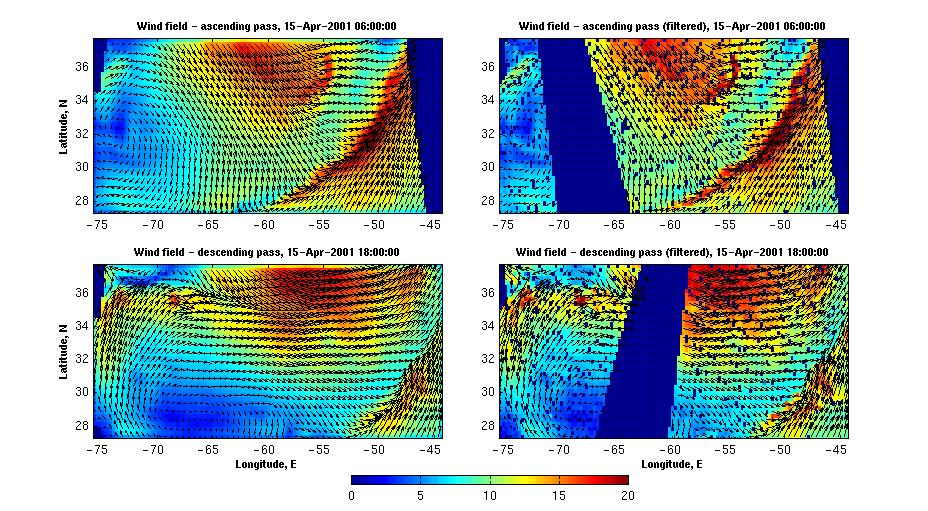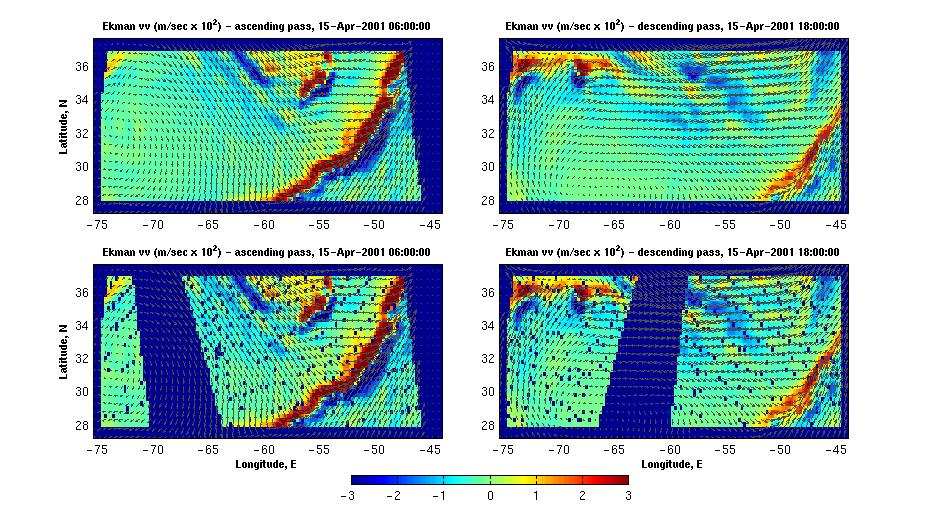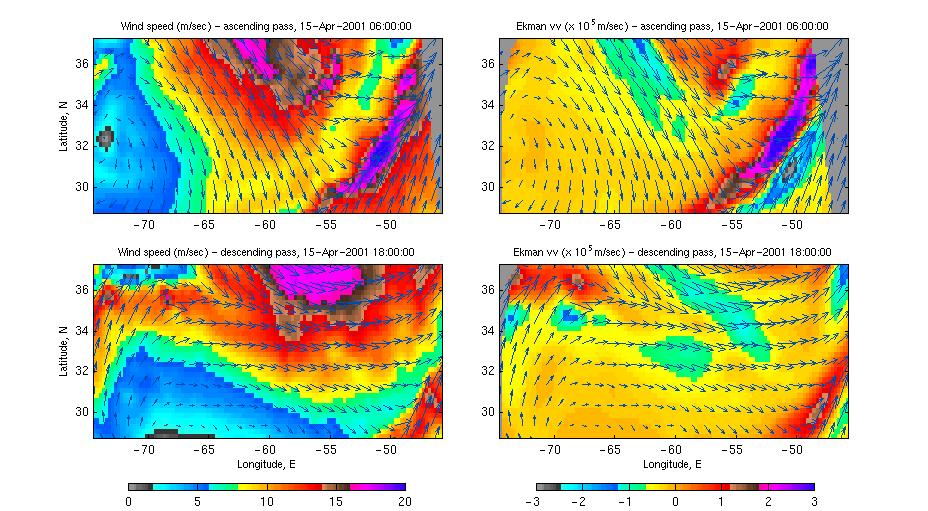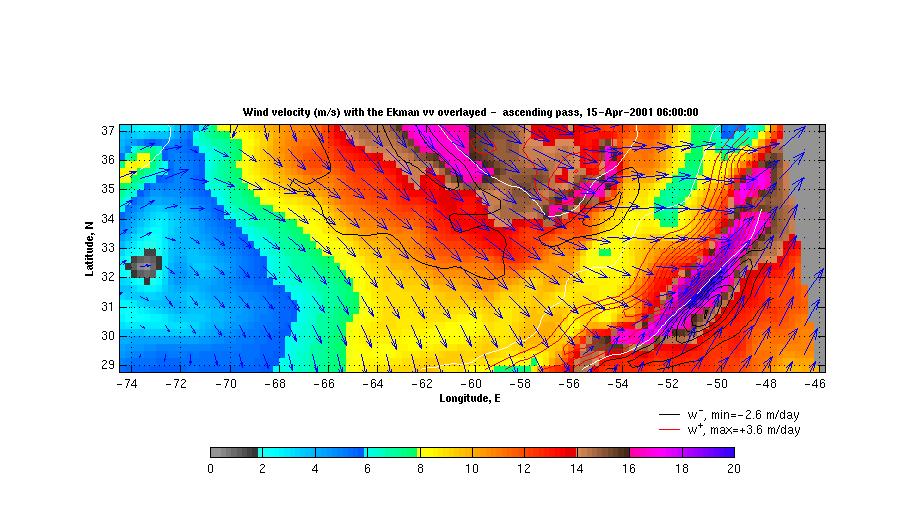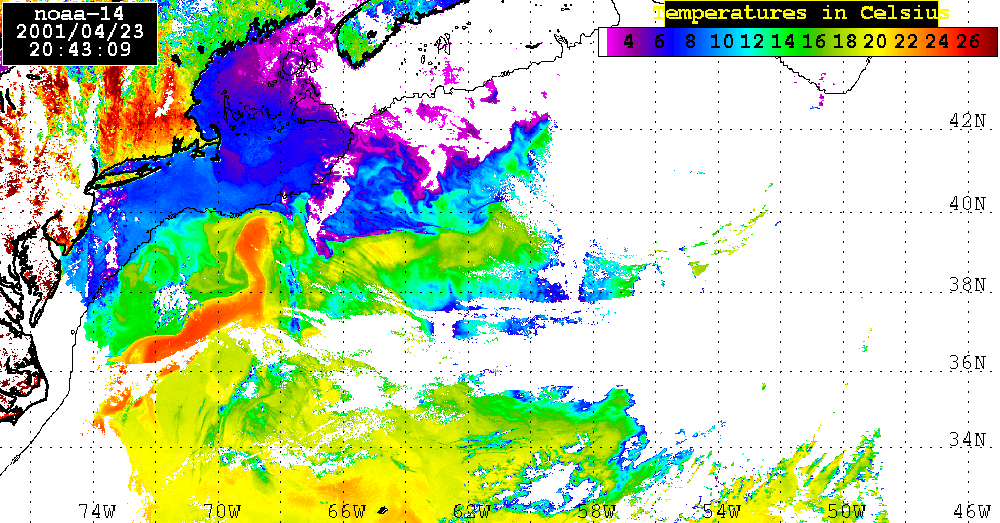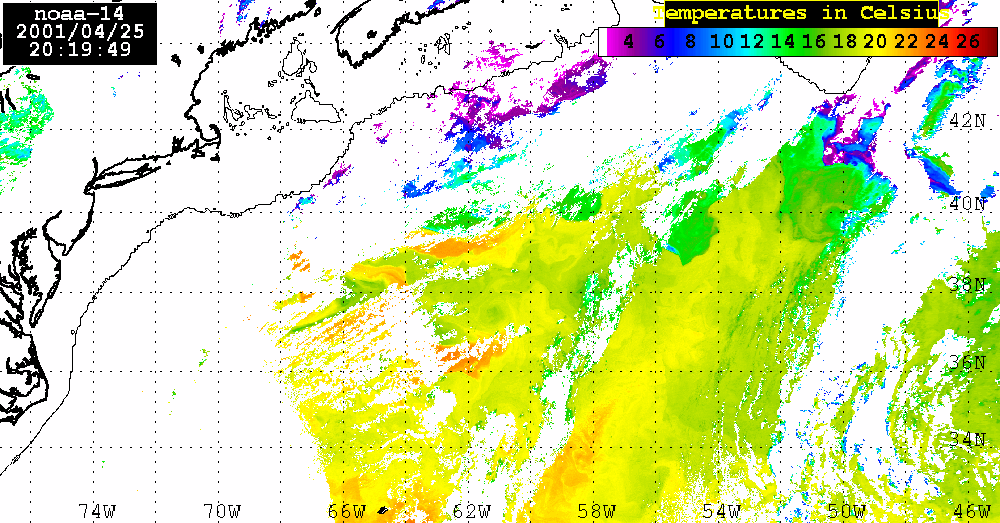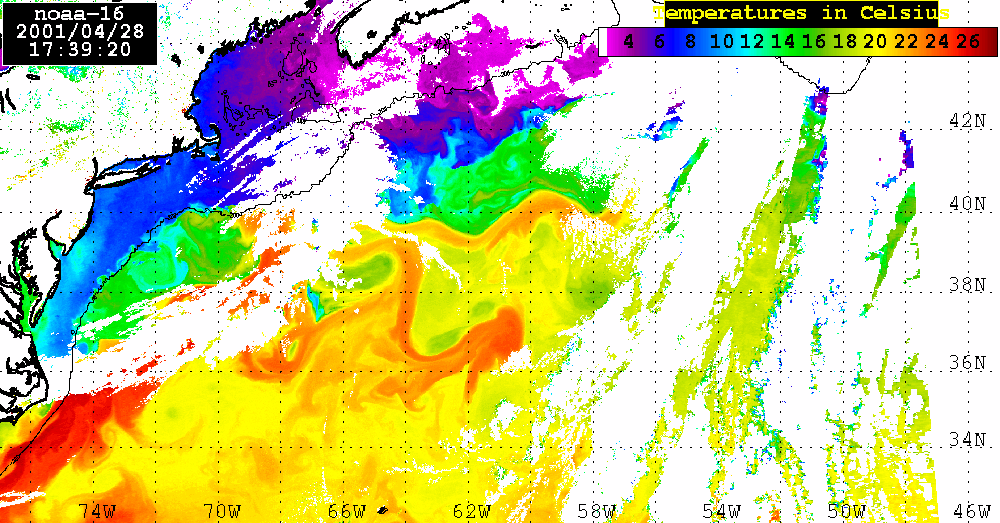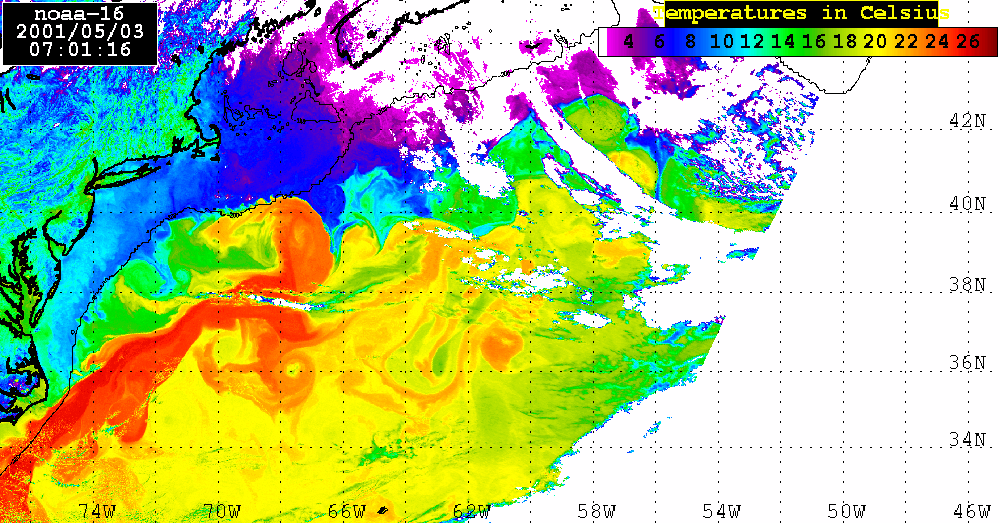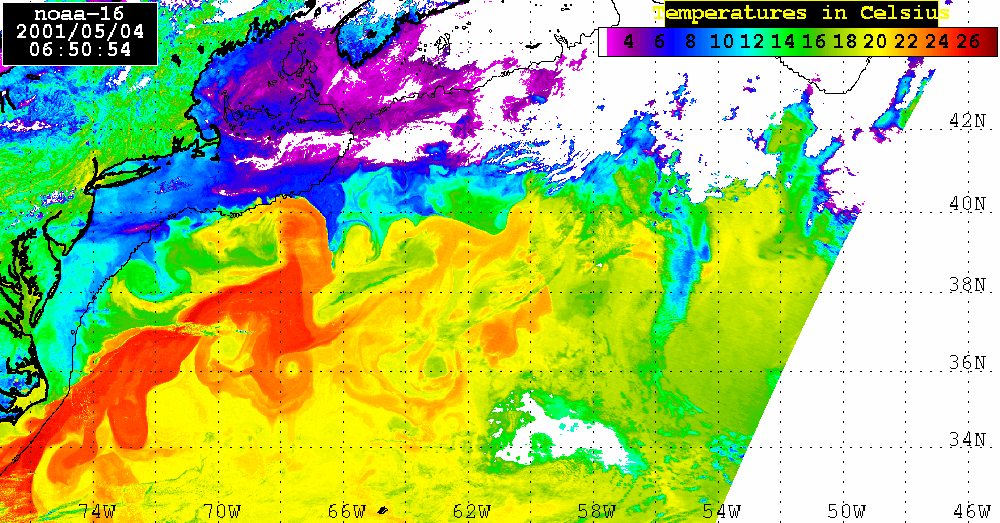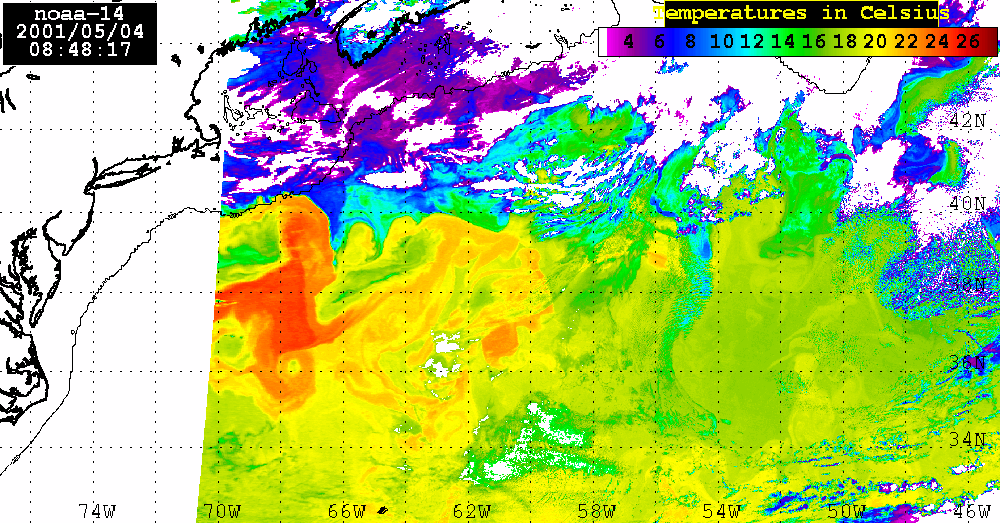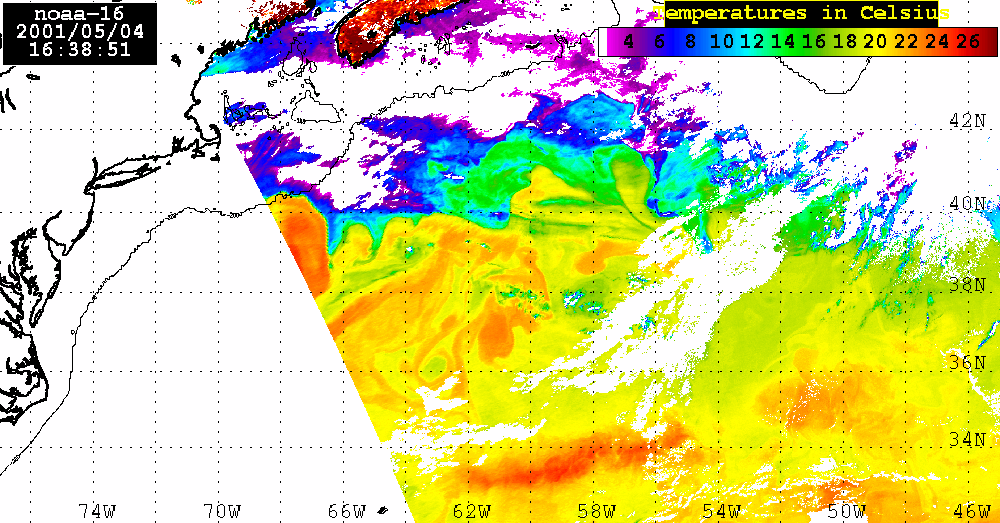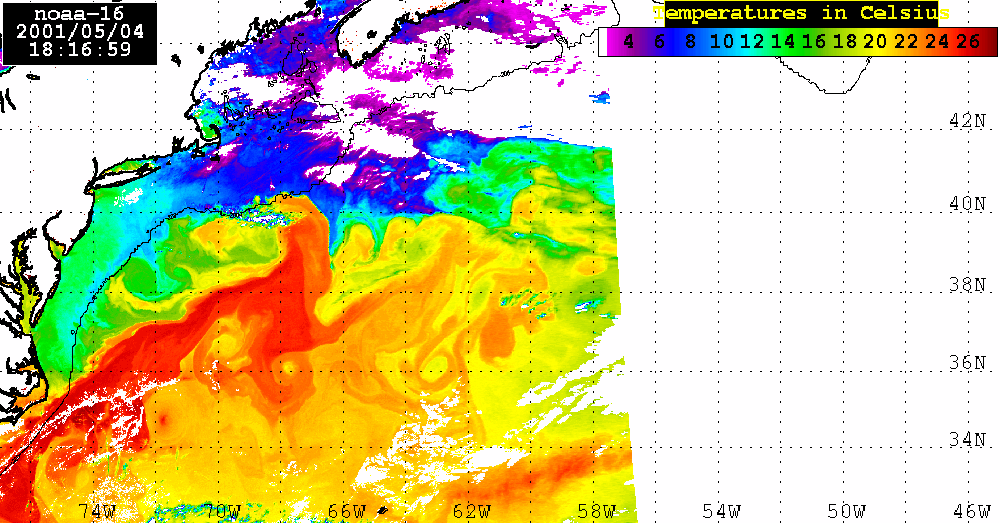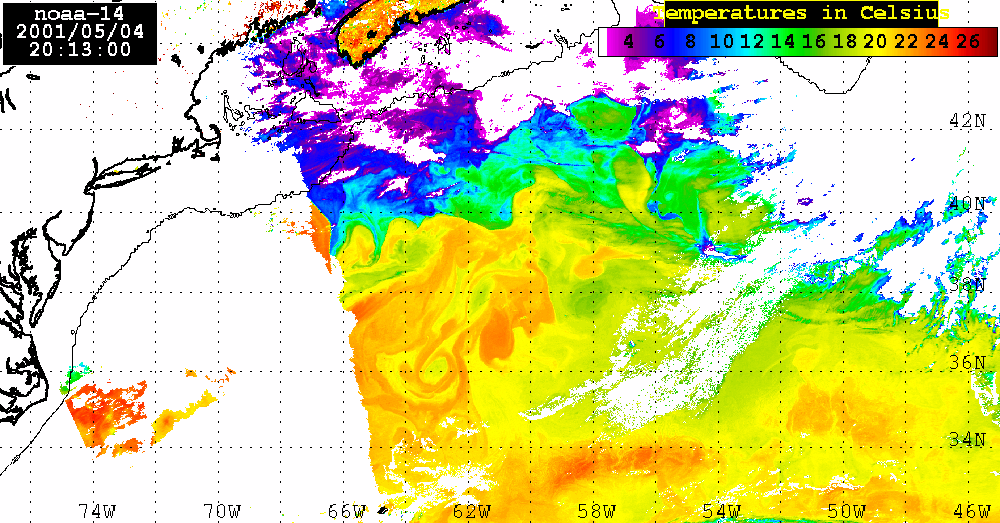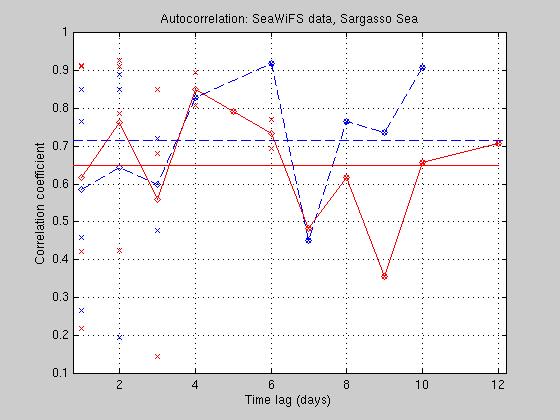The SeaWinds on QuikSCATSummary:The SeaWinds on QuikSCAT Level 3 data set consists of gridded values of scalar wind speed, meridional and zonal components of wind velocity, wind speed squared and time given in fraction of a day. Rain probability determined using the Multidimensional Histogram (MUDH) Rain Flagging technique is also included as an indicator of wind values that may have degraded accuracy due to the presence of rain. Data are currently available in Hierarchical Data Format (HDF) and exist from 19 July 1999 to present time. The Level 3 data were obtained from the Direction Interval Retrieval with Threshold Nudging (DIRTH) wind vector solutions contained in the QuikSCAT Level 2B data and are provided on an approximately 0.25° x 0.25° global grid. Separate maps are provided for both the ascending pass (6 AM LST equator crossing) and descending pass (6 PM LST equator crossing). Scaling factor * 100 has been applied to the wind speed (m/sec). By maintaining the data at nearly the original Level 2B sampling resolution and separating the ascending and descending passes, very little overlap occurs in one day. However, when overlap between subsequent swaths does occur, the values are over-written, not averaged. Therefore, a SeaWinds on QuikSCAT Level 3 file contains only the latest measurement for each day. This product is also referred to as JPL PO.DAAC product 109. Grid Description: The QuikSCAT Level 3 data set is on a simple, rectangular grid of 1440 columns by 720 rows. Therefore, a grid element spans 0.25 degrees in longitude (360/1440) and latitude (180/720). Latitude and longitude coordinates are assigned to each grid element based on its center. To calculate the longitude and latitude of a grid point, the following equations can be used:
lon[i] = (360./XGRID) * (i+0.5)
where:
As shown by the above formulas, the latitude and longitude of the center of the first grid cell of each QuikSCAT Level 3 scientific data is -89.875° North (89.875° South) and 0.125° East. The latitude and longitude of the final grid cell of each data set is centered at 89.875° North and 359.875° East (0.125° West). The following map displays the ocean surface winds at a 10m height from ascending and descending satellite passes as processed by NOAA/NESDIS, from near real-time data collected by NASA/JPL's SeaWinds Scatterometer aboard the QuikSCAT.
Flag file Description: asc_wvc_count: distinguishes NULL values from zero value of wind speed in the ascending pass data. If asc_wvc_count is 0 in a given cell, wind retrieval did not take, and wind speed values are NULL in that cell. If asc_wvc_count is 1, wind retrieval occurred, and a 0 value of wind speed indicates a measurement of 0 m/s. Data and processing: The objective of this study is to get a wind product with realistic high temporal/spatial resolution and to compare this product (wind field, wind stress and wind stress curl) to mesoscale fields in the Sargasso Sea. The Atlantic Ocean from 28°N to 36°N
and from 60°W to 70°W ("large" domain) was chosen as the region
to generate QSCAT daily wind fields. QSCAT data began on 19 July 1999,
and extended (currently) up to 30 June, 2002. The coverage of QSCAT
is extensive, giving a continuous swath of 1,800 km, providing wind vector
measurements over 90% of the ice-free global oceans each day.
Despite the high quality and excellent
A different technique was used to create regularly gridded daily wind maps from QSCAT ( or NSCAT ) scatterometer observations, see fo example, Zeng and Levy (1995), P. Polito et al (2000), W.T. Liu et al (1998, 2000), M. Bourassa et al (1999). Space based wind measurements either have to be subjected to averaging within a certain temporal and spatial bin, or be interpolated with some type of smoothing or filtering. The simplest way to form a daily gridded winds is just to take an average of the ascending and descending data for the same day. But the main problem in such mapping is to prevent the appearance of swath patterns in wind fields is still remains. The other hand, space-time interpolation and filtering result in smoother wind field but reduce the energy it contains. A proper interpolation of QSCAT data is intended to alleviate this drawback, and, what is very important, retains greater energy content at high wavenumbers. Let's overview briefly a few more methods that have been used recently to process QSCAT/NSCAT data. 1. The correlation-based interpolation method (P. Polito et al, 2000) uses a sequence of regularly gridded maps of a wind speed component as input. These maps may have data gaps, indicated by a numerical flag, which requires interpolation. The three-dimensional autocorrelation coefficient matrices derived directly from daily bin averaged maps in a regular grid used for the interpolation onto the same grid. The autocorrelation matrices are continuously updated in space and time. The algorithm starts by estimating the autocorrelation
coefficients in the volume limited by the maximum zonal, meridional and
temporal lags which are set 4°, 3°, and 2 days. The autocorrelation
coefficients are calculated at each grid point using spatial (xl,yl)
and temporal (tl)
C(xl, yl, tl) = 1/( 1 + sqrt( 2 x tl²
+ 0.5 xl² + 0.5 x yl²))
2. The approach developed in Bourassa et al, 1999, retains the dominance of winds observed on the day in question, and it also allows for a relatively smooth transition into regions where there were no observations, or smoothly fill the gaps. First of all, a binning procedure was applied to the 25-km resolution NSCAT winds. The bin size was chosen 50 km to include sufficient observations. Then the weighting procedure analogous to a weighted vector average of 1-, 2-, 4-, and 8-day averages was applied to binned winds. Each of this averaging periods was centered on 1200 UT of the day in question. The weighting mechanism is designed to favor observations in the short averaging periods. The 8-day averaging period was sufficiently long that there are observations in each grid box. The effective averaging window is reduced through a weighted average u4* of the 8-day u8 and 4-day u4 fields. The effective averaging window is the further reduced by averaging the product u4* with 2-day and 1-day averages. The key equations are
u4* = (n4 x u4 + n8 x u8)/(n4+n8),
u2* = (n2 x u2 + n4* x u4*)/(n2+
n4*),
where n is the number of observations in a given cell. Increasing the value of the weighting parameter ß sharpens the fit to u1 at the expense of smooth fields near swath edges. It was found a value of ß=5 to be optimal. 3. Another one method developed by Timothy Liu et al, 1998, objectively interpolates NSCAT winds by the method of successive corrections. The interpolation scheme starts with the NSCAT monthly bin-averaged field as an initial guess field. Then, NSCAT observations within the radius of influence (R) and the period of influence (T) of the chosen grid point are used to make corrections iteratively. The value of T was chosen 1.5 days, and R decreases from 10 grid-spacing to 1 during the 5 successive iterations. The contributions of observations to the correction term were weighted differently according to their positions relative to the grid point under analysis. Observations were screened out if the difference between them and the interpolated value of the analyzed field exceeds the maximum allowable error (E). E decreases from 50 m/sec to 3 m/sec over the 5 iterations. The key point for the successive corrections is imbedded in the equation ugn+1 = ugn + ß Cn where ß is a weighting factor and Cnis
the correction term representing the impact from the observations. To produce
a map of a particular time T, the value on each grid point is initialized
by the NSCAT monthly bin-averaged field.
Next the error Esn, the difference between the actual measured scatterometer value us at location "s" and the guess value interpolated from the analyzed field at the same location, is computed: Esn = us - ugsn Observed data were rejected if this error value exceeds the maximum allowable error (Emax) as given in table (not shown). This error limit is a decreasing function of iteration passes, allowing increasing confidence in the analyzed field with each successive iteration. The error function Esn is used to correct the guess field value on grid points for the (n+1)-th iteration. The correction term is given by
Cn = E Wsn
Esn / E Wsn
Of course, the advantages and disadvantages of each the above listed methods depend on the application of the wind field product. Wind field computation: The ascending and descending data were averaged together to form daily composites of wind field with no smoothing. Then, these maps were interpolated onto the T/P diamond domain in same manner as it was described above, and used in the next analysis. Also, the relatively simple binning and weighting
method of Bourassa et al, 1999 has been used to produce daily
wind field and its derivatives (e.g., curl and divergence) over the T/P
diamond domain. First, daily winds were produced for the "large"
domain, then cubically interpolated onto the T/P diamond. The resulting
fields are used to examine a possible connection of surface winds
with mesoscale features observed at BATS site.
Results. a. daily averages from ascending /descending passes An example of daily averages mapping presented in fig. 1a. -- how the daily composites have been created, fig.1b -- daily winds, and fig.1c -- daily wind stress curl. The whole data set can be scrolled day by day using la_wind_99_02.fli (winds), or la_curl_99_02.fli (wind stress curl) movie. b. daily averages from space-time smoothing As an alternative to simple averaging described above, the space-time filtering was applied to daily averages to remove small-scale variability and noise. The running 8 points ( 8 days) gaussian filter was used to smooth the time-series in each pixel. Then the running box ( 5 x 5 points, or 1o x 1o ) gaussian filter was applied to each image. An example of such smoothing displayed here -- la_wind_ts_filt.fli. c. description of the tests and error analysis for the method of Bourassa et al The NSCAT wind fields from July 1 through September 30, 2002 were used to test a smoothing technique. The figure below presents results from test comparing results from daily composites and the Bourassa et al, 1999, algorithms ( also, scroll day by day results of this test using av_filt_12.fli movie ).
A little loss of information is clearly
seen in smoothed map. Same time, zone of low winds is now more accurately
described due to corrected ambiguity selection.
d. mapping individual ascending/descending passes In some cases when analyzing simultaneously satellite data like SeaWiFS imagery, a corresponding synoptic scale wind data are required. The main problem related to getting daily scatterometer data is that the observational tracks from different times (passes) intersect, often with substantial changes in wind pattern occurring between the observations. Simple averaging would result in spurious wind curl and divergence which then can lead to incorrect conclusions. To avoid such situation a simultaneous wind data from individual ascending/descending passes have been mapped and analyzed. As a first step, gaps in wind field were
filled using 2D cubic interpolation and compared to the original data.
An example of such interpolation and comparison is shown below. To scroll
data between April 1, 2001 and May 10, 2001 click here
/wind #1/.
Next plot displays corresponding Ekman vertical velocity field during same period of time.
To scroll data between April 1, 2001 and
May 10, 2001 click here
/wind #2/.
Finally, next 2 plots display wind field with the Ekman vertical velocity overlaid.  or same field with max/min values vertical velocity displayed (larger domain).
Analysis of the combined SeaWiFS, AVHRR and QuikSCAT data.The SeaWiFS data set analyzed here consists of 4 consecutive LAC Level 2 Chl_a maps for April 23, 25, 28, and May 4, 2001. During these dates a large areas of the Sargasso Sea were visible which permits us to calculate Chl_a distribution using SEADAS package. Of course, there is a lot of missing data in each map owing to cloud cover or to low incident sunlight. Nevertheless, combining ocean color observations obtained from SeaWiFS, surface winds derived from QuikSCAT, sea level anomalies (SLA) from altimetry, and sea surface temperature (SST) from AVHRR, we examine the role of atmospheric forcing in ocean's physics and biology.SeaWiFS
SeaWiFS + SLA
|
